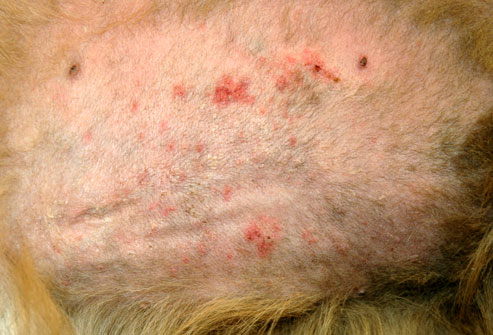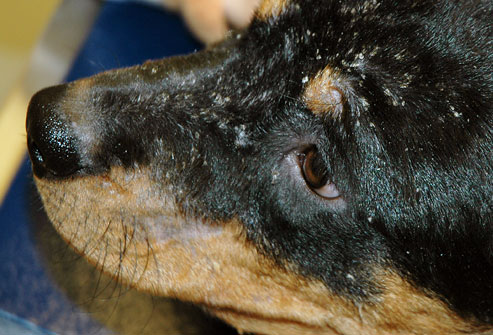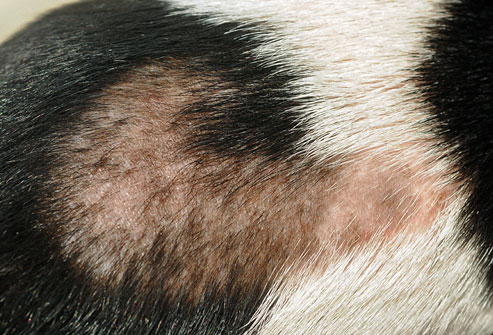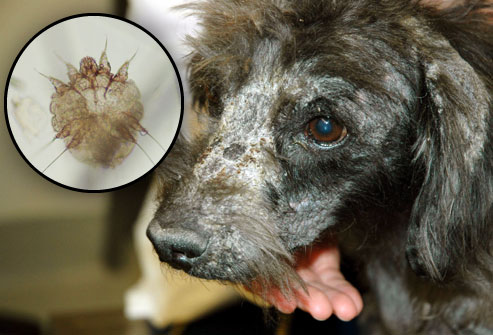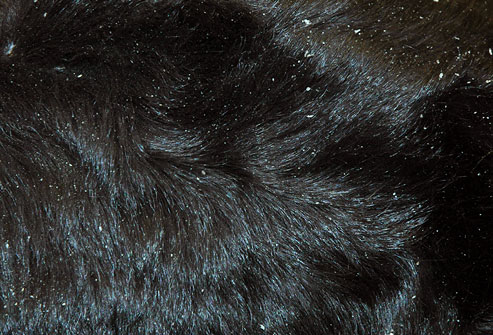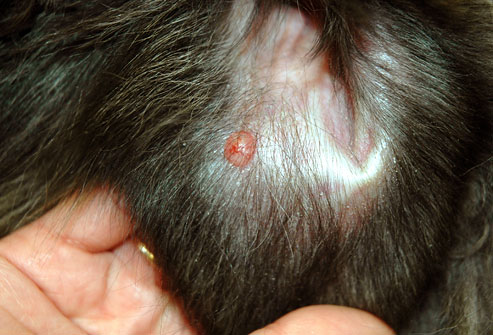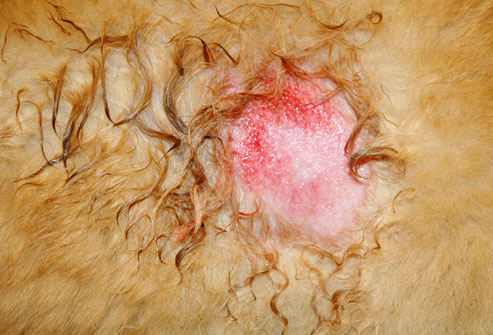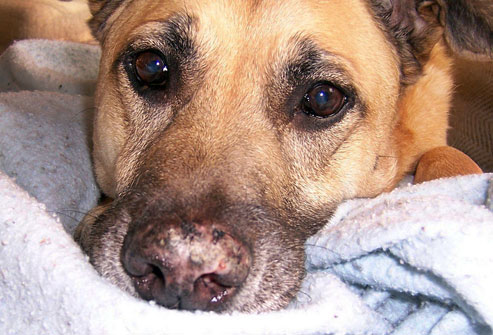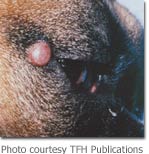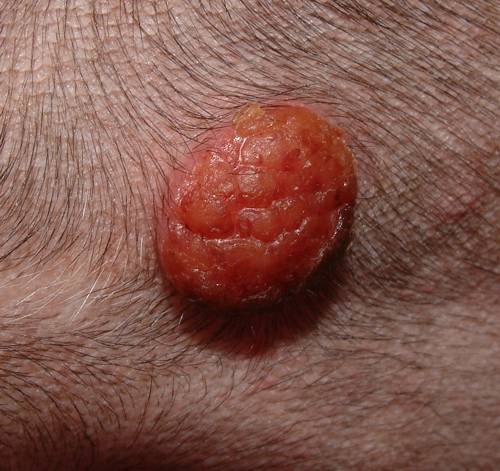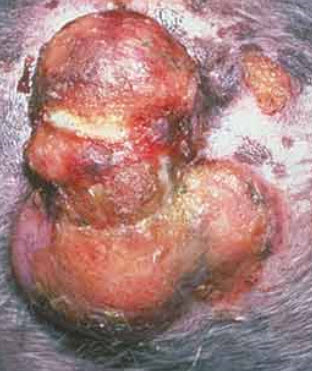Ear infections
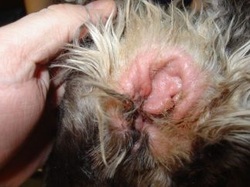
- Otitis Externa - Commonly referred to as an "ear infection", otitis externa is a condition characterized by inflammation of the external ear canal. It is particularly prevalent in dogs with long, floppy ears such as beagles.
- Ear infections represent one of the top 10 reasons dogs are brought to
veterinarians and these infections may affect up to 20 percent of dogs.
Common signs of an ear infection are scratching at the ears or shaking the head, as well as odor, inflammation and discharge in the ear.
Skin Allergies/Dermatitis
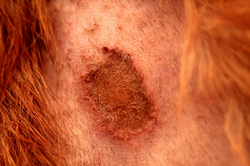
- Skin Allergies/Dermatitis -
- Flea allergy dermatitis is the most common allergy in dogs and is caused
by flea bites, specifically the saliva of the flea. The disease typically
results in excessive itching and it predisposes dogs to the development of
secondary skin infections in the irritated areas. Another common skin
allergy is caused by “atopy,” an allergy to environmental substances. Signs
of skin allergies are itching, redness, and hair loss.
Urinary Track Infection

Bacterial Canine Urinary InfectionBacteria can told hold anywhere in the urinary tract and cause a dog urinary infection. Sometimes the infection will not produce any noticeable symptoms. Bacteria usually enters the body from the area where your dog urinates.
Urine is your dog's first defense against infection. When the urine has the proper PH balance (base/acid mix) and urea (primary component in urine that is created by the liver), then it works to fight off infection.
To determine if you dog has an infection your veterinarian will look for symptoms that are associated with problem urination such as:
There are several types of bacteria that can cause the problem. X-rays or ultrasound may be used if the formation of a stone is suspected in the upper tract. To view the lower tract an endoscopy, a video camera that is at the end of a thin tube is used.
A stone is a collection of crystals that formed into an object that can get large enough to block a urinary passage. Another name for stones is urolith. Your veterinarian will try and determine if the problem is in the lower or upper urinary tract.
To treat a canine urinary infection your veterinarian will rely on antibiotics for a period up to 14 days and then test 7 days later to see if the infection is gone. Longer treatment may be needed for stubborn infections.
If your dog gets more than 3 infections in a year, that more aggressive treatment may be needed using a process called antimicrobial therapy.
You can help your dog avoid bacterial infections by using some home remedies. These include:
Cranberry Juice: this type of juice has properties which improve the acid level in the urine. The juice also has properties which help to protect the bladder.
Walks: Talk your dog out for 2 additional walks each day. Dogs will increase the amount they urinate and feel they need to drink just by being outside. The urine flushes the urinary tract.
Homeopathic Remedies: Certain herbs such as Berberis vulgaris is known to support the urinary tract and the immune system. Others help to maintain a the correct PH in the urine. One product made for this purpose and is worth considering is UTI Free.
Fungal Dog Urinary InfectionIn rare cases, a fungus will be the cause of your dog's problem, usually in the lower urinary tract. The fungus is called Candida spp. Unlike bacteria which enters from outside the body, fungus usually comes from the kidneys into the urinary system.
Other problems are often present including diabetes mellitus. The problem could have also been caused by recent medical procedures such as the insertion of a catheter into the urinary tract. Medications such as antibiotics, chemotherapy agents and steroids can also be the cause. Your veterinarian will also closely examine the lower urinary tract.
Diagnosis of the dog urinary infection is done with a simple yeast test. Often if the underlying problem is correct such as treatment for diabetes or the end of therapy with antibiotics, the problem will resolve itself. If it doesn't then a medication can be prescribed using the drug fluconazole. Other drug choices are ketoconazole and itraconazole, although these might not be as effective. A new medication called amphotericin B is showing promise in people and may become common for canine care.
Treatment for dog urinary infection lasts for 2 to 4 weeks. After treatment your dog will be tested to make sure the infection is gone.
Urine is your dog's first defense against infection. When the urine has the proper PH balance (base/acid mix) and urea (primary component in urine that is created by the liver), then it works to fight off infection.
To determine if you dog has an infection your veterinarian will look for symptoms that are associated with problem urination such as:
- Frequency of Urination
- Strength of the urine stream
- Blood in the Urine (could be a sign that infection spread to kidneys)
- Urine Leaking at night
- Urination in the house
There are several types of bacteria that can cause the problem. X-rays or ultrasound may be used if the formation of a stone is suspected in the upper tract. To view the lower tract an endoscopy, a video camera that is at the end of a thin tube is used.
A stone is a collection of crystals that formed into an object that can get large enough to block a urinary passage. Another name for stones is urolith. Your veterinarian will try and determine if the problem is in the lower or upper urinary tract.
To treat a canine urinary infection your veterinarian will rely on antibiotics for a period up to 14 days and then test 7 days later to see if the infection is gone. Longer treatment may be needed for stubborn infections.
If your dog gets more than 3 infections in a year, that more aggressive treatment may be needed using a process called antimicrobial therapy.
You can help your dog avoid bacterial infections by using some home remedies. These include:
Cranberry Juice: this type of juice has properties which improve the acid level in the urine. The juice also has properties which help to protect the bladder.
Walks: Talk your dog out for 2 additional walks each day. Dogs will increase the amount they urinate and feel they need to drink just by being outside. The urine flushes the urinary tract.
Homeopathic Remedies: Certain herbs such as Berberis vulgaris is known to support the urinary tract and the immune system. Others help to maintain a the correct PH in the urine. One product made for this purpose and is worth considering is UTI Free.
Fungal Dog Urinary InfectionIn rare cases, a fungus will be the cause of your dog's problem, usually in the lower urinary tract. The fungus is called Candida spp. Unlike bacteria which enters from outside the body, fungus usually comes from the kidneys into the urinary system.
Other problems are often present including diabetes mellitus. The problem could have also been caused by recent medical procedures such as the insertion of a catheter into the urinary tract. Medications such as antibiotics, chemotherapy agents and steroids can also be the cause. Your veterinarian will also closely examine the lower urinary tract.
Diagnosis of the dog urinary infection is done with a simple yeast test. Often if the underlying problem is correct such as treatment for diabetes or the end of therapy with antibiotics, the problem will resolve itself. If it doesn't then a medication can be prescribed using the drug fluconazole. Other drug choices are ketoconazole and itraconazole, although these might not be as effective. A new medication called amphotericin B is showing promise in people and may become common for canine care.
Treatment for dog urinary infection lasts for 2 to 4 weeks. After treatment your dog will be tested to make sure the infection is gone.
Conjunctivitis
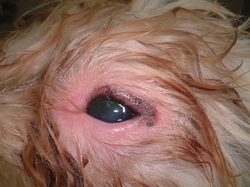
with periocular alopecia and purulent conjunctivitis ...
- Conjunctivitis
Another common condition is an inflammation of the conjunctiva, which is
the tissue coating the eye and lining the eyelids. Conjunctivitis is a
common eye problem in dogs. It may be the only eye disease present, or may
be associated with other diseases or eye problems. Common signs are redness
of the conjunctiva, squinting, eye discharge or scratching at the eyes.
Skin Masses or growths
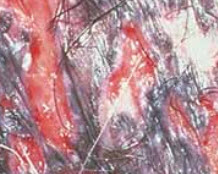
Ulcer: an ulcer is a skin lesion that is accompanied by puss. The underlying skin becomes exposed and inflamed. It indicates allergic reaction, injury or a immune system problem
Skin growths are lumps of tissue that are within the skin or can be felt under
the skin. Dogs can develop small bumps (papules) or
larger bumps (nodules) on their skin. These lumps and bumps are fairly common
occurrences, especially in the older dog.
Very often the word "lump"
brings the word "cancer" to mind. However, there are many other
causes of lumps. A skin growth or mass may be a malignant or benign tumor, an
abscess, a cyst, a hematoma (blood-filled mass) or a reaction by the skin to an
allergen (hives). Lumps are often benign
accumulations of fat called lipomas.
However, all lumps should be evaluated for the possibility of malignancy.
Skin masses can arise for a very large number of reasons, including
infections, tumors, parasites, injury, cysts (clogged or inflamed glands), warts
and calluses. Masses can range in size from pinpoint to many inches in diameter.
It can often be difficult to determine the underlying cause without skin or lab
tests.
True tumors (cancer) can be benign, or aggressive and life-threatening.
Sometimes a "tumor" may really turn out to be a wart, a callus, a cyst or an
inflamed area of skin.
All skin masses should be evaluated by a veterinarian. Increased risk of
having a life threatening problem if you see the skin mass grow, change, or
become painful, ulcerated or infected.
Diagnosis is based on symptoms, examination findings and skin or lab tests
that may include taking a sample of the mass for microscopic analysis.
Treatment can vary widely based on the type and size of the mass. Not all
masses will require treatment. If the mass is suspicious, immediate removal and
microscopic testing may be recommended. All questionable masses should be
addressed as soon as possible. Sometimes, the early removal of a cancerous mass
can prevent the spread of cancer to other places in the body.
IMPORTANT POINT
Use all medications as prescribed by your veterinarian.
What to Watch For
Any new lump or bump should be
evaluated right away, especially a lump that is rapidly growing, is warm or
painful, is ulcerated or bleeding, is irregular in shape or is well attached to
the tissues under the skin. Any of the above signs should prompt you to seek veterinary attention.
the skin. Dogs can develop small bumps (papules) or
larger bumps (nodules) on their skin. These lumps and bumps are fairly common
occurrences, especially in the older dog.
Very often the word "lump"
brings the word "cancer" to mind. However, there are many other
causes of lumps. A skin growth or mass may be a malignant or benign tumor, an
abscess, a cyst, a hematoma (blood-filled mass) or a reaction by the skin to an
allergen (hives). Lumps are often benign
accumulations of fat called lipomas.
However, all lumps should be evaluated for the possibility of malignancy.
Skin masses can arise for a very large number of reasons, including
infections, tumors, parasites, injury, cysts (clogged or inflamed glands), warts
and calluses. Masses can range in size from pinpoint to many inches in diameter.
It can often be difficult to determine the underlying cause without skin or lab
tests.
True tumors (cancer) can be benign, or aggressive and life-threatening.
Sometimes a "tumor" may really turn out to be a wart, a callus, a cyst or an
inflamed area of skin.
All skin masses should be evaluated by a veterinarian. Increased risk of
having a life threatening problem if you see the skin mass grow, change, or
become painful, ulcerated or infected.
Diagnosis is based on symptoms, examination findings and skin or lab tests
that may include taking a sample of the mass for microscopic analysis.
Treatment can vary widely based on the type and size of the mass. Not all
masses will require treatment. If the mass is suspicious, immediate removal and
microscopic testing may be recommended. All questionable masses should be
addressed as soon as possible. Sometimes, the early removal of a cancerous mass
can prevent the spread of cancer to other places in the body.
IMPORTANT POINT
Use all medications as prescribed by your veterinarian.
What to Watch For
Any new lump or bump should be
evaluated right away, especially a lump that is rapidly growing, is warm or
painful, is ulcerated or bleeding, is irregular in shape or is well attached to
the tissues under the skin. Any of the above signs should prompt you to seek veterinary attention.
|
|
Dog Skin Infection
Dog Skin Infection Treatment
Treatment for dog skin infection varies by the types of dog skin
disorders:
Bacterial Skin Infection as cause of Dog Skin Disorders:Like
most infections, antibiotics are used when a bacterial problem is diagnosed.
Bacterial infections are often caused by another condition (secondary infection)
such as allergy, an immune mediated skin reaction or a hormonal problem
(endocrine issue). There are different types of bacteria that can lead to a
bacterial skin infection in dog. Testing will determine the specific type of
canine bacterial skin problem to be treated. Antibiotic therapy usually lasts
for 3 to 12 weeks depending on the severity of the condition.
Canine Fungal Skin Infection as cause of Dog Skin
Disorders:A dog fungal skin infection is diagnosed with a device called
a "woods lamp" which is used to check skin appearance under the light. Skin
scraping tests will confirm any diagnosis that is made. A class of medications
called antimycotic agents are prescribed to treat canine fungal skin infection.
These include Griseofulvin (administered with meal) and Ketoconazole (tablets).
Side effects of treatment can include vomiting, diarrhea and nausea depending on
the medication selected.
Tests will be conducted 2 and 4 weeks after testing to confirm that all of
the dog skin disorders have been properly treated.
Treatment for dog skin infection varies by the types of dog skin
disorders:
Bacterial Skin Infection as cause of Dog Skin Disorders:Like
most infections, antibiotics are used when a bacterial problem is diagnosed.
Bacterial infections are often caused by another condition (secondary infection)
such as allergy, an immune mediated skin reaction or a hormonal problem
(endocrine issue). There are different types of bacteria that can lead to a
bacterial skin infection in dog. Testing will determine the specific type of
canine bacterial skin problem to be treated. Antibiotic therapy usually lasts
for 3 to 12 weeks depending on the severity of the condition.
Canine Fungal Skin Infection as cause of Dog Skin
Disorders:A dog fungal skin infection is diagnosed with a device called
a "woods lamp" which is used to check skin appearance under the light. Skin
scraping tests will confirm any diagnosis that is made. A class of medications
called antimycotic agents are prescribed to treat canine fungal skin infection.
These include Griseofulvin (administered with meal) and Ketoconazole (tablets).
Side effects of treatment can include vomiting, diarrhea and nausea depending on
the medication selected.
Tests will be conducted 2 and 4 weeks after testing to confirm that all of
the dog skin disorders have been properly treated.
Foreign Body Ingestion

Dogs, like children, are curious animals and love to play. However, they also like to chew on their toys and, as a result, sometimes swallow harmful objects that can affect their health. It is important that you protect your dog from ingesting dangerous foreign bodies.
A gastrointestinal foreign body refers to any material other than food that is eaten and that results in serious digestive problems. Foreign bodies can become lodged in the stomach and intestines creating an obstruction. Commonly ingested non-food items include toys, string, clothing, and plastic. In fact, any household object your dog chews on can become a foreign body problem.
Dogs of any age are susceptible to developing foreign body problems but this is most commonly seen in young dogs less than 2 years of age. These youngsters are naturally curious and enjoy playing. Popular chew toys for dogs are socks, shoes, pantyhose and underwear. Frequently, while playing and chewing on these items, the dog may unintentionally ingest some or all of the material. Although some smaller foreign bodies can pass through the gut without getting stuck and causing a problem, the larger pieces can result in serious gastrointestinal complications.
What to Watch For
Dogs that have ingested a foreign object usually show signs of gastrointestinal upset. If your dog refuses to eat, begins vomiting, drooling or has abnormal bowel movements, contact your veterinarian. In some instances, you may notice a foreign object, such as a string, protruding from the rectum. Do not try to pull the object out - consult your vet.
Diagnosis
Your veterinarian will begin by obtaining a complete and thorough medical history, including recent chewing on foreign material. A physical examination will follow. If a foreign body is suspected, abdominal radiographs (x-rays) will be recommended. Most foreign objects can be confirmed on plain x-rays but a few elusive ones may require a dye material like barium in order for diagnosis.
Since removal of most foreign bodies requires surgery, once a gastrointestinal foreign body is diagnosed, your veterinarian may order blood tests to assess the general health of your dog.
Treatment
Most dogs with a gastrointestinal foreign body obstruction have been vomiting or not eating for a period of time. This leads to dehydration and electrolyte imbalance. Your veterinarian will most likely want to hospitalize your dog and administer intravenous fluids prior to anesthesia. Once he is more stable, he will be anesthetized and prepared for surgery.
After sedation, your dog will have his mid abdomen shaved. Your veterinarian will make an incision along the center of the abdomen and will examine the stomach and intestines for foreign material or obstructions. Then he will make another small incision in the stomach and/or intestine to remove the foreign material. In severe obstructions, he may have to make multiple and if portions of the intestine have been damaged, he may also need to remove sections of the intestine.
After the foreign body is removed, your veterinarian will suture the incision in the stomach and/or intestine as well as the body wall and skin. Your dog will continue to receive intravenous fluids until he is able to eat and drink without vomiting. Your veterinarian may prescribe medication for pain such as butorphanol as well as antibiotics to prevent infection. Based on the severity of intestinal damage, your dog may be hospitalized for 2-5 days.
Surgical removal of foreign objects is a common procedure in veterinary medicine. During the surgery the intestines, as well as other abdominal organs, can be examined for damage or illness. Unfortunately, every surgery has negative aspects such as post-operative pain, potentially long hospital stays and possible infection. Surgery is the only treatment for intestinal obstruction so your veterinarian will take steps to either treat for or prevent some of the surgical complications.
Home Care
Once your dog is able to eat and drink without vomiting, he'll be able to come home. Be sure to give all medication as prescribed by your veterinarian and periodically check the incision.
Sutures are generally removed in 7-10 days. Until then, do not allow your dog to lick or chew at the sutures – an Elizabethan collar may be necessary. You should also watch the incision for swelling or discharge. Your dog will need to be fed a bland diet for 2-3 days and gradually return to a normal diet. Baby food and prescription bland diets are typically recommended. Contact your veterinarian if your dog refuses to eat or begins vomiting.
Preventative Care
The best way to prevent your dog from ingesting foreign bodies is to prevent access to objects that could be swallowed. Keep dangerous objects away from your dog and allow him to chew only on toys that cannot be swallowed. Never let him play with string or clothing.
If you suspect that your dog may have ingested something that may not pass through his intestinal tract, contact your veterinarian. Waiting until your pet starts to vomit will make removal of the foreign material more difficult and costly.
A gastrointestinal foreign body refers to any material other than food that is eaten and that results in serious digestive problems. Foreign bodies can become lodged in the stomach and intestines creating an obstruction. Commonly ingested non-food items include toys, string, clothing, and plastic. In fact, any household object your dog chews on can become a foreign body problem.
Dogs of any age are susceptible to developing foreign body problems but this is most commonly seen in young dogs less than 2 years of age. These youngsters are naturally curious and enjoy playing. Popular chew toys for dogs are socks, shoes, pantyhose and underwear. Frequently, while playing and chewing on these items, the dog may unintentionally ingest some or all of the material. Although some smaller foreign bodies can pass through the gut without getting stuck and causing a problem, the larger pieces can result in serious gastrointestinal complications.
What to Watch For
Dogs that have ingested a foreign object usually show signs of gastrointestinal upset. If your dog refuses to eat, begins vomiting, drooling or has abnormal bowel movements, contact your veterinarian. In some instances, you may notice a foreign object, such as a string, protruding from the rectum. Do not try to pull the object out - consult your vet.
Diagnosis
Your veterinarian will begin by obtaining a complete and thorough medical history, including recent chewing on foreign material. A physical examination will follow. If a foreign body is suspected, abdominal radiographs (x-rays) will be recommended. Most foreign objects can be confirmed on plain x-rays but a few elusive ones may require a dye material like barium in order for diagnosis.
Since removal of most foreign bodies requires surgery, once a gastrointestinal foreign body is diagnosed, your veterinarian may order blood tests to assess the general health of your dog.
Treatment
Most dogs with a gastrointestinal foreign body obstruction have been vomiting or not eating for a period of time. This leads to dehydration and electrolyte imbalance. Your veterinarian will most likely want to hospitalize your dog and administer intravenous fluids prior to anesthesia. Once he is more stable, he will be anesthetized and prepared for surgery.
After sedation, your dog will have his mid abdomen shaved. Your veterinarian will make an incision along the center of the abdomen and will examine the stomach and intestines for foreign material or obstructions. Then he will make another small incision in the stomach and/or intestine to remove the foreign material. In severe obstructions, he may have to make multiple and if portions of the intestine have been damaged, he may also need to remove sections of the intestine.
After the foreign body is removed, your veterinarian will suture the incision in the stomach and/or intestine as well as the body wall and skin. Your dog will continue to receive intravenous fluids until he is able to eat and drink without vomiting. Your veterinarian may prescribe medication for pain such as butorphanol as well as antibiotics to prevent infection. Based on the severity of intestinal damage, your dog may be hospitalized for 2-5 days.
Surgical removal of foreign objects is a common procedure in veterinary medicine. During the surgery the intestines, as well as other abdominal organs, can be examined for damage or illness. Unfortunately, every surgery has negative aspects such as post-operative pain, potentially long hospital stays and possible infection. Surgery is the only treatment for intestinal obstruction so your veterinarian will take steps to either treat for or prevent some of the surgical complications.
Home Care
Once your dog is able to eat and drink without vomiting, he'll be able to come home. Be sure to give all medication as prescribed by your veterinarian and periodically check the incision.
Sutures are generally removed in 7-10 days. Until then, do not allow your dog to lick or chew at the sutures – an Elizabethan collar may be necessary. You should also watch the incision for swelling or discharge. Your dog will need to be fed a bland diet for 2-3 days and gradually return to a normal diet. Baby food and prescription bland diets are typically recommended. Contact your veterinarian if your dog refuses to eat or begins vomiting.
Preventative Care
The best way to prevent your dog from ingesting foreign bodies is to prevent access to objects that could be swallowed. Keep dangerous objects away from your dog and allow him to chew only on toys that cannot be swallowed. Never let him play with string or clothing.
If you suspect that your dog may have ingested something that may not pass through his intestinal tract, contact your veterinarian. Waiting until your pet starts to vomit will make removal of the foreign material more difficult and costly.
Vomiting

Sudden Onset of Vomiting in Dogs
It is not uncommon for dogs and cats to vomit from time to time. They might have eaten something that upset their stomachs, or just have sensitive digestive systems. However, it becomes acute when the vomiting does not stop and when there is nothing left in the stomach to throw up except bile (a yellow fluid). It is important you take your pet to a veterinarian in these types of cases.
While vomiting may have a simple, straightforward cause, it may be an indicator of something far more serious. It is also problematic because it can have a wide range of causes, and determining the correct one may be quite complicated.
Symptoms
Causes
Diagnosis
Bring a sample of the vomit to the veterinarian. If there is a lot of mucus, an inflamed intestine may be the cause. Undigested food in the vomit can be due to food poisoning, anxiety, or simply overeating. Bile, on the other hand, indicates an inflammatory bowel disease or inflammation of the pancreas (pancreatitis). If bright red blood is found, the stomach could be ulcerated. However, if the blood is brown and looks like coffee grounds, the problem may be in the intestine. Finally, strong digestive odors are usually observed when there is an intestinal obstruction.
The veterinarian will generally look in your pet’s mouth for foreign objects that may be wedged inside, such as a bone. Enlarged tonsils are another good indicator for this. The pet’s temperature will be taken and an examination of the abdomen will be done. If it turns out to be no more than a passing incident, the veterinarian may ask you to limit the diet to clear fluids and to collect stool samples over that period as the underlying cause may be passed along in the stool. Occasionally, the animal's body may use vomiting to clear the intestines of toxins.
Treatment
Treatment will be recommended according to the underlying cause behind the
vomiting; some possibilities include:
Dietary changes
Living and Management
Always follow the recommended treatment plan from your veterinarian. Do not
experiment with medications or food. Pay close attention to your pet and if it
does not improve, return to your veterinarian for a follow-up evaluation.
It is not uncommon for dogs and cats to vomit from time to time. They might have eaten something that upset their stomachs, or just have sensitive digestive systems. However, it becomes acute when the vomiting does not stop and when there is nothing left in the stomach to throw up except bile (a yellow fluid). It is important you take your pet to a veterinarian in these types of cases.
While vomiting may have a simple, straightforward cause, it may be an indicator of something far more serious. It is also problematic because it can have a wide range of causes, and determining the correct one may be quite complicated.
Symptoms
- Vomiting that will not stop
- Pain and distress
- Weakness
- Bright blood in the vomit or stool (hematemesis)
- Evidence of dark blood in the vomit or stool (melena)
Causes
- Dietary indiscretion
- Change in diet
- Gobbling food/eating too fast
- Intolerance to a particular food (i.e., be careful feeding pets food intended for humans)
- Allergic reaction to a particular food
- Obstructing objects
- Acute inflammation of stomach (gastroenteritis)
- Parasites (e.g., whipworms, roundworms, giardia)
- Dislocation of the stomach (prone in deep-chested dogs; very critical)
- Tumors
- Metabolic disorders (e.g., kidney disease)
- Liver disease
- Heat stroke
- Adrenal gland disease
Diagnosis
Bring a sample of the vomit to the veterinarian. If there is a lot of mucus, an inflamed intestine may be the cause. Undigested food in the vomit can be due to food poisoning, anxiety, or simply overeating. Bile, on the other hand, indicates an inflammatory bowel disease or inflammation of the pancreas (pancreatitis). If bright red blood is found, the stomach could be ulcerated. However, if the blood is brown and looks like coffee grounds, the problem may be in the intestine. Finally, strong digestive odors are usually observed when there is an intestinal obstruction.
The veterinarian will generally look in your pet’s mouth for foreign objects that may be wedged inside, such as a bone. Enlarged tonsils are another good indicator for this. The pet’s temperature will be taken and an examination of the abdomen will be done. If it turns out to be no more than a passing incident, the veterinarian may ask you to limit the diet to clear fluids and to collect stool samples over that period as the underlying cause may be passed along in the stool. Occasionally, the animal's body may use vomiting to clear the intestines of toxins.
Treatment
Treatment will be recommended according to the underlying cause behind the
vomiting; some possibilities include:
Dietary changes
- Medication to control the vomiting (e.g., cimetidine, anti-emetic)
- Antibiotics, in the case of bacterial ulcers
- Corticosteroids to treat inflammatory bowel disease
- Surgery, in the case of tumor-caused vomiting
- Special medications for treating chemotherapy induced vomiting
Living and Management
Always follow the recommended treatment plan from your veterinarian. Do not
experiment with medications or food. Pay close attention to your pet and if it
does not improve, return to your veterinarian for a follow-up evaluation.
Panting

dog panting is surely a sign of some underlying health problem if it occurs
consistently and in the absence of its indicators, i.e. after exercise, running,
hot weather or in brachyocephallic breeds. Several other signs accompany
excessive panting in dogs, such as cough, discomfort, heart problems, anemia, heat strokes, fainting etc.
A panting puppy might be of concern, when it is a
perfectly normal response to heat or exercise. A puppy is considered to be
panting when the breathing rate is 10x the normal rate.
Causes of Dog Panting:
Panting in dogs is mostly caused by common environmental and physiological
factors, such as: anxiety, heat, excitement,fear, excessive exercise, and running.
In most cases, the common reasons for dog panting are considered normal or a
mere response to the environmental and behavioral factors. But, in cases where
there is discomfort, stress and other signs are also accompanied with consistent
canine panting, an underlying cause or possible health problem should be
diagnosed and treated specifically.
The following are some of the possible causes of abnormal and excessive
panting in dogs, which may be a real threat to dog health, not to mention that some of them if not
attended to immediately can turn fatal.
Symptoms of Abnormal Dog Panting:
Canine panting after exercise, running, in hot weather and in certain breeds
is considered normal. However,in dogs which pant consistently and show signs of
stress, discomfort, cough, difficult breathing and visible distress should be
referred to a veterinarian for detailed examination. Clinically, dog panting can
never be a confirmatory sign for any possible health problem, but other signs
such as anemia, darkened skin and mucus, weight loss, lethargy, intolerance,
cough, fatigue, thirst and dehydration can suggest the possible degree of
severity of the condition.
Clinical examination initiated due to signs of excessive panting in dogs may
lead to reveal an underlying respiratory, cardiovascular and other systemic
diseases, therefore dog owners are always directed to monitor the breathing
pattern, panting behavior and stress level of their pets, which if appear
abnormal could be an indicator of a serious underlying systemic disease.
Diagnosis of Abnormal Dog Panting:
A dog referred to a veterinarian with abnormal panting problem is examined in
detail; it is always first determined if the panting is part of the normal dog
physiological response to exercise, weather or an internal temperature
controlling mechanism. Once the dog panting is confirmed as abnormal as part of
a clinical examination or any other symptoms or underlying causes are suspected,
a veterinarian may use additional examination tools and laboratory
diagnosis.
Along with the dogs history and physical examination, detailed laboratory
tests including blood examination, dog blood count, hematology, chest X-Rays,
urinalysis, and biochemical profiling is done initially. This can be followed by
more specific tests as Endocrine examination, heartworm tests, cardiovascular
examinations and Thoracentesis (also known as pleural fluid analysis,
thoracentesis is a procedure that removes fluid or air from the chest through a
needle or tube) to confirm the possible underlying cause of abnormal canine
panting.
Treatment of Abnormal or Excessive Panting in Dogs:
Since dog panting is related to the functioning of vital body systems, i.e.
respiratory system, cardiovascular system and other systems which depend on the
normal functioning of these features, initial symptomatic treatment is initiated
even before the basic diagnosis is determined.
Symptoms such as abnormal canine breathing and panting are treated with the
help of providing extra oxygen and room to breath. Anemia (if present) is
treated with a blood transfusion. Dehydrated dogs due to excessive exercise,
work, hot weather are administered fluids, in which high energy content such as
lactose is added.
Natural remedies, which can enhance the dogs energy level are highly
recommended along with the specific treatment initiated by a veterinarian. A
natural solution for restoring energy levels would be the homeopathic remedy Energy Tonic.
Excessive panting in dogs
has many reasons, for example anxiety due to any discomfort and environmental
factors is one of primary causes. The natural remedyGrief and Pining Formula is primarily recommended
for those pets which are experiencing some kind of loss or separation. It
contains Hypericum, which is a herb with properties that help to stabilize mood
and the nervous centers in brain. Pet Calm is another remedy which can be used an
alternative to this product, although it does not contain Hypericum in favor of
other ingredients which promote nervous system health.
Once the diagnosis is confirmed, specific treatment should be initiated
immediately. Specific treatment can be done with the help of therapeutics or may
require surgical procedures, depending upon the confirmation made with help of
advanced diagnostic techniques.
consistently and in the absence of its indicators, i.e. after exercise, running,
hot weather or in brachyocephallic breeds. Several other signs accompany
excessive panting in dogs, such as cough, discomfort, heart problems, anemia, heat strokes, fainting etc.
A panting puppy might be of concern, when it is a
perfectly normal response to heat or exercise. A puppy is considered to be
panting when the breathing rate is 10x the normal rate.
Causes of Dog Panting:
Panting in dogs is mostly caused by common environmental and physiological
factors, such as: anxiety, heat, excitement,fear, excessive exercise, and running.
In most cases, the common reasons for dog panting are considered normal or a
mere response to the environmental and behavioral factors. But, in cases where
there is discomfort, stress and other signs are also accompanied with consistent
canine panting, an underlying cause or possible health problem should be
diagnosed and treated specifically.
The following are some of the possible causes of abnormal and excessive
panting in dogs, which may be a real threat to dog health, not to mention that some of them if not
attended to immediately can turn fatal.
- Respiratory Problems: In
Brachyocephallic breeds of dogs, panting is a normal phenomenon, but consistent
panting in these breeds and other dogs due to respiratory distress represents a
serious underlying cause, such as upper and lower respiratory tract infection,
nasal congestion, nasal and throat growths (tumors,
tonsils), collapsed trachea, inadequate exchange of gases in lungs, pulmonary
edema or accumulation of fluids in the lungs and pressure on respiratory
features from tumors and/or hernias in the chest cavity. - Heart/Cardiovascular Problems: Since
the respiratory and cardiovascular mechanisms are tied to each other in the
normal physiology of body, i.e. exchange of gases in the lungs and
transportation of oxygen and nutrients with help of the cardiovascular
mechanism, therefore abnormal dog panting is directly related to cardiovascular
and heart problems. In cases where there is canine cardiovascular diseases,
heart congestion, hematological problems (related with blood), heart worm
infestation, pulmonary blockage may cause pressure on the oxygen and nutrient
supply to every cell of the body. In such cases, a neurological response in the
brain initiates a pressurized respiratory response, i.e. excessive intake of air
through the nostrils through panting and heavy breathing. - Neurological Problems: Since, the
breathing and respiratory mechanism is controlled by a “Respiratory Center” in
the hind brain; any neurological disorder such as head trauma, brain tumors, in
coordination of respiratory muscles and pressure over the center may initiate
uncontrolled intake of air, which eventually leads to persistent dog panting and
heavy breathing. - Miscellaneous Problems: Along with
the aforementioned core causes of abnormal dog panting, several other reasons
such as heat illness, poisoning, high altitudes, ascites or accumulation of
fluids in the abdomen, abdominal pressure due to pregnancy and/or cancerous
growths and certain chest/abdominal diseases also cause pressure on the chest
cavity and respiratory system. These causes eventually leave a dog with heavy
breathing and consistent panting.
Symptoms of Abnormal Dog Panting:
Canine panting after exercise, running, in hot weather and in certain breeds
is considered normal. However,in dogs which pant consistently and show signs of
stress, discomfort, cough, difficult breathing and visible distress should be
referred to a veterinarian for detailed examination. Clinically, dog panting can
never be a confirmatory sign for any possible health problem, but other signs
such as anemia, darkened skin and mucus, weight loss, lethargy, intolerance,
cough, fatigue, thirst and dehydration can suggest the possible degree of
severity of the condition.
Clinical examination initiated due to signs of excessive panting in dogs may
lead to reveal an underlying respiratory, cardiovascular and other systemic
diseases, therefore dog owners are always directed to monitor the breathing
pattern, panting behavior and stress level of their pets, which if appear
abnormal could be an indicator of a serious underlying systemic disease.
Diagnosis of Abnormal Dog Panting:
A dog referred to a veterinarian with abnormal panting problem is examined in
detail; it is always first determined if the panting is part of the normal dog
physiological response to exercise, weather or an internal temperature
controlling mechanism. Once the dog panting is confirmed as abnormal as part of
a clinical examination or any other symptoms or underlying causes are suspected,
a veterinarian may use additional examination tools and laboratory
diagnosis.
Along with the dogs history and physical examination, detailed laboratory
tests including blood examination, dog blood count, hematology, chest X-Rays,
urinalysis, and biochemical profiling is done initially. This can be followed by
more specific tests as Endocrine examination, heartworm tests, cardiovascular
examinations and Thoracentesis (also known as pleural fluid analysis,
thoracentesis is a procedure that removes fluid or air from the chest through a
needle or tube) to confirm the possible underlying cause of abnormal canine
panting.
Treatment of Abnormal or Excessive Panting in Dogs:
Since dog panting is related to the functioning of vital body systems, i.e.
respiratory system, cardiovascular system and other systems which depend on the
normal functioning of these features, initial symptomatic treatment is initiated
even before the basic diagnosis is determined.
Symptoms such as abnormal canine breathing and panting are treated with the
help of providing extra oxygen and room to breath. Anemia (if present) is
treated with a blood transfusion. Dehydrated dogs due to excessive exercise,
work, hot weather are administered fluids, in which high energy content such as
lactose is added.
Natural remedies, which can enhance the dogs energy level are highly
recommended along with the specific treatment initiated by a veterinarian. A
natural solution for restoring energy levels would be the homeopathic remedy Energy Tonic.
Excessive panting in dogs
has many reasons, for example anxiety due to any discomfort and environmental
factors is one of primary causes. The natural remedyGrief and Pining Formula is primarily recommended
for those pets which are experiencing some kind of loss or separation. It
contains Hypericum, which is a herb with properties that help to stabilize mood
and the nervous centers in brain. Pet Calm is another remedy which can be used an
alternative to this product, although it does not contain Hypericum in favor of
other ingredients which promote nervous system health.
Once the diagnosis is confirmed, specific treatment should be initiated
immediately. Specific treatment can be done with the help of therapeutics or may
require surgical procedures, depending upon the confirmation made with help of
advanced diagnostic techniques.
Dehydration

Causes of Dog Dehydration:
Most of a dog’s body weight is comprised of water, which is estimated to be
79% of the total. It is estimated that if a dog’s body losses even 10% of body
fluids, the condition may result in severe dehydration, which should be
considered a medical emergency which requires immediate treatment.
Dog Dehydration
As described above dog dehydration happens when there is a reduction of fluid
intake or an excessive amount of fluid loss. A dog not drinking or eating enough
due to sickness can cause a reduction of fluid intake. An excessive amount of
fluid loss can be caused by a number of health problems such as:
Not drinking enough water
Different types of illnesses
Recuperating from surgery
Overexposure to heat
Fever
Vomiting
Diarrhea
Lack of desire to eat or drink water
Overexertion
Stress, excessive panting and drooling can lead to fluid loss
Dry mouth
Tremors
Dehydration in dogs can be a symptom of any underlying medical condition.
Most commonly, infectious or non infectious diseases which cause diarrhea,
vomiting or frequent urination may leave a dog dehydrated.
Similarly, some mechanical and environmental factors such as excessive heat,
lower levels of water intake during the winter and excessive panting can cause
the loss of body fluids, leaving a dog with mild to severe dehydration.
In general, canine dehydration is caused by medical conditions related to the
digestive and urinary system, exposure to harsh weather, injuries and
illness.
Symptoms and Diagnosis of Canine Dehydration:
A dog may appear to be slightly or severely dehydrated. Dehydration in dogs
should be assessed based on different common symptoms such as dullness, a
lethargic appearance, increased heart rate but slower pulse rate, paleness and
dryness over gums, dryness over the skin and delayed capillary refill time.
Veterinarians can also assess dehydration on the basis of these symptoms by
specifically formulating an index for the different symptoms and by taking a
clinical history of the condition along with the diagnosis of any possible
underlying cause. Along with these symptoms, other conditions such as body
temperature, blood pressure, rate of fluid absorption and urination etc are part
of the assessment.
Treating Dog Dehydration:
Dehydration in dogs should be considered a medical emergency. Even if a dog
owner suspects minor dehydration, they should try to try and address it
immediately or consult with a veterinarian for proper handling. Severe
dehydration on other hand should never be treated at home.
There are different ways to approach canine dehydration treatment
symptomatically, which includes:
Most of a dog’s body weight is comprised of water, which is estimated to be
79% of the total. It is estimated that if a dog’s body losses even 10% of body
fluids, the condition may result in severe dehydration, which should be
considered a medical emergency which requires immediate treatment.
Dog Dehydration
As described above dog dehydration happens when there is a reduction of fluid
intake or an excessive amount of fluid loss. A dog not drinking or eating enough
due to sickness can cause a reduction of fluid intake. An excessive amount of
fluid loss can be caused by a number of health problems such as:
Not drinking enough water
Different types of illnesses
Recuperating from surgery
Overexposure to heat
Fever
Vomiting
Diarrhea
Lack of desire to eat or drink water
Overexertion
Stress, excessive panting and drooling can lead to fluid loss
Dry mouth
Tremors
Dehydration in dogs can be a symptom of any underlying medical condition.
Most commonly, infectious or non infectious diseases which cause diarrhea,
vomiting or frequent urination may leave a dog dehydrated.
Similarly, some mechanical and environmental factors such as excessive heat,
lower levels of water intake during the winter and excessive panting can cause
the loss of body fluids, leaving a dog with mild to severe dehydration.
In general, canine dehydration is caused by medical conditions related to the
digestive and urinary system, exposure to harsh weather, injuries and
illness.
Symptoms and Diagnosis of Canine Dehydration:
A dog may appear to be slightly or severely dehydrated. Dehydration in dogs
should be assessed based on different common symptoms such as dullness, a
lethargic appearance, increased heart rate but slower pulse rate, paleness and
dryness over gums, dryness over the skin and delayed capillary refill time.
Veterinarians can also assess dehydration on the basis of these symptoms by
specifically formulating an index for the different symptoms and by taking a
clinical history of the condition along with the diagnosis of any possible
underlying cause. Along with these symptoms, other conditions such as body
temperature, blood pressure, rate of fluid absorption and urination etc are part
of the assessment.
Treating Dog Dehydration:
Dehydration in dogs should be considered a medical emergency. Even if a dog
owner suspects minor dehydration, they should try to try and address it
immediately or consult with a veterinarian for proper handling. Severe
dehydration on other hand should never be treated at home.
There are different ways to approach canine dehydration treatment
symptomatically, which includes:
- Oral Electrolytes and Fluids:Minor cases of dehydration can
be treated with oral administration of fluids which contain electrolytes. Also,
in medical conditions where vomiting is not the primary symptom, or oral intakes
do not cause the dog to vomit, these fluids can be administered as well. Care is
needed in the preparation and administration of these fluids. If oral fluids are
required to be administered for treating dog dehydration, these should not be
given in bulk or in larger quantities at once. Intead a minor volume of fluid
several times a day is preferred. Common pedialyte, plain water containing salts
etc can be used, but not in larger volumes, as these may end with the dog
vomiting, which means more loss of fluids. - Fluid Therapy: In severe dog dehydration or true medical
emergencies, fluids can be administered through an Intra-Venous (IV) route or
Sub-Cutaneous (SC) route. These fluids are administered in the form of Ringer
Lactate solution combined with electrolytes such as sodium and potassium.
Administering fluids through injections is done as the initial procedure in
medical emergencies. Once the dog is rehydrated and saved, underlying causes are
treated. - Home Remedies: In order to treat mild
dehydration or to prevent the occurrence of dog dehydration at all, dogs should
be offered plenty of clean water. Moreover, if the dog experiences diarrhea or
vomiting, it should be referred to a veterinarian before it gets dehydrated. At
home, pedialyte and plain water can be an effective dog dehydration treatment in
cases of mild dehydration. - Specific Treatment: Canine dehydration always has an
underlying cause. Once the normal level of water and fluids in the body is
attained, conditions should be treated specifically according to a confirmed
diagnosis. It should be noted that specific drugs such as antibiotics, anti
fungals, anti parasitic drugs and other drugs for specific symptoms are never
recommended, while a dog is dehydrated. These should only be administered once
the patient is rehydrated.




